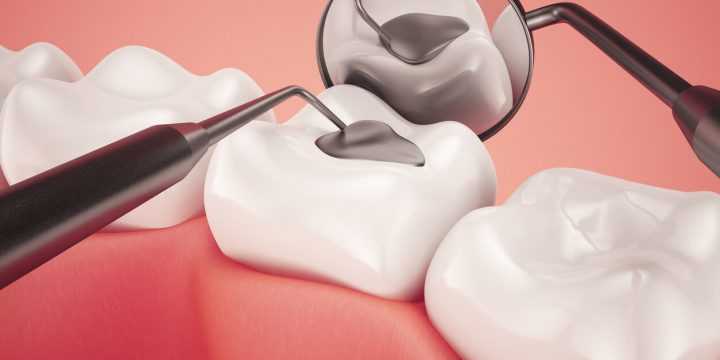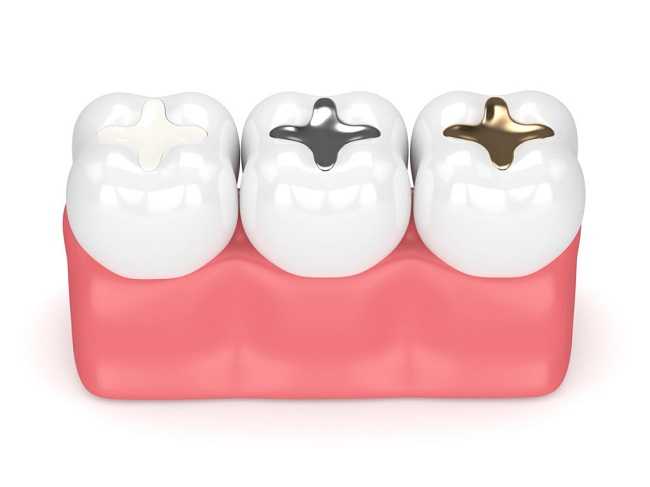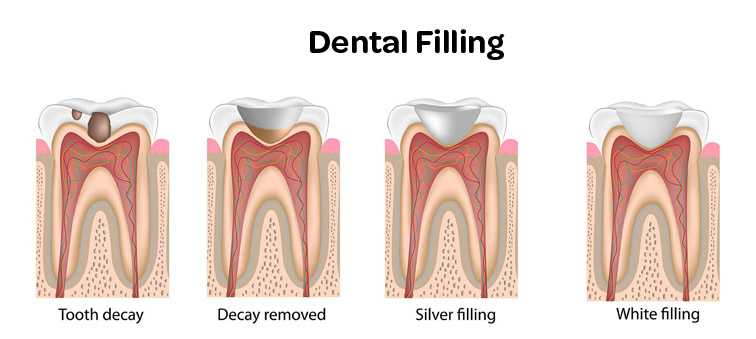Tooth Filling / Dental Filling
In dental filling, the decayed part of the tooth that has cavities is cleaned properly. After cleaning, the space is then filled with proper dental material to protect it from further damage. Different types of filling, like porcelain, gold filling, silver, amalgam, plastics, and other types of materials are used on the surface of the tooth.

Talk to a Dentist Now!
What is Teeth Filling?
Teeth decay results in cavities and these are a very common condition found in people. In the ideal scenario, tooth decay must be treated as early as possible to prevent it from spreading deeper into a tooth or to other teeth in the mouth. Teeth filling is a procedure by which early-stage tooth decay is treated and the tooth’s function and aesthetics restored.
One of the many causes of sensitive teeth is tooth decay. When the decay causes cavitation into the dentine layer, it elicits a sensitivity response to cold food or air and this is one of the first symptoms that your tooth needs a filling.
Teeth filling is a procedure wherein the dentist removes the decayed portion of a tooth and fills the cavity formed with an appropriate filling material. Promptly filling a tooth helps in fighting tooth decay and prevents its further spread into the tooth.
Why is Cavity Filling Required?

Dental decay is brought about by bacteria that use food debris around a tooth as substrate and produce acids that dissolve the tooth structure, in a way eating into the tooth. As a result, a cavity is formed.
Many of you wonder – “What if a cavity is not filled?” Well, when a cavity is formed in the tooth, it weakens the structure of the tooth.
A cavity is filled with a strong material that replaces the lost structure of the tooth, to restore its form and function, and in many cases, even its aesthetics.
Types of Teeth Filling

There are different types of teeth filling material and most people wonder which is the best teeth filling material? You can discuss with your dentist the best teeth filling material option for you as the decision is based on many factors such as – the extent of decay, cost of the filling, and convenience. Some commonly used teeth-filling materials are:-
- Silver Amalgam: This is probably one of the oldest and long-standing teeth-filling materials that has been used for over 100 years and continues to be used. These filling materials are made from silver and mercury, are cheap, and have high wear resistance. They can withstand high compressive forces but fracture under high tension.
Though extremely popular and widely used, they are not aesthetic and have a metallic appearance. For this reason, they aren’t the choice of filling in front teeth.
- Glass Ionomer Filling: Glass ionomer filling is a luting cement that is used to fix dental crowns and bridges or line cavities. They are used in some conditions even today due to their fluoride-releasing abilities.
However, compared to silver amalgam and composites, they have very poor compressive strength and are also less retentive to the tooth structure.
- Composites: These are resin-based teeth-filling materials and are the most widely used materials today. They have superior aesthetics as well as strong compressive and tensile strengths.
This makes them ideal for cavities in the front and back teeth. They bond chemically with the tooth structure and therefore, also have good retention.
Composites are available in different shades and the right shade is chosen by your dentist based on the shade and color of your tooth.
- Porcelain Inlays and Onlays- Inlays and onlays, unlike the above-mentioned filling materials, are indirect restorations. This means that they are not directly placed on the tooth structure but are pre-fabricated in a dental lab and luted onto the tooth to restore the cavity.
They show superior aesthetics and closely resemble the color and shade of the tooth to be restored.
The right tooth filling material for your tooth is, therefore, decided based on multiple factors. At Sabka Dentist clinics, we provide teeth-filling materials of superior grade and our dentists are well-trained to make the right choice of tooth-filling material based on each case.
How is a Teeth Filling Done?
So, what do teeth filling involve? Teeth filling is usually done in one sitting when you visit your dentist.

However, some deeper fillings may require additional sittings. The three steps involved in teeth filling are:
- Evaluation-
When you visit our Sabka Dentist clinic, the dentist will first evaluate your tooth for the extent of the decay, its spread, and any symptoms that you may have. An x-ray might be taken to study the extent of the decay inside the tooth. Once the dentist is sure that the decay has not reached the pulp and can be treated with a filling, he/she proceeds further.
- Removing the decay and cleaning your tooth –
The next step is the removal of the decay. The dentist will remove all of the decayed portions of the tooth and clean the cavity of any debris that may be present. The tooth is now ready to be filled.
- Filling – The final step in the teeth-filling procedure is the placement of the appropriate filling material in the prepared cavity and finishing it off with specialized hand tools. Your tooth is as good as new! Post your filling, your dentist may give you a few instructions that you must follow.
What if the Cavity is Deep?
Many of you must be wondering “What if the cavity is deep? Well, if on the x-ray and by clinical evaluation your dentist feels that the cavity is too deep for a filling or removal of the decay will result in exposure of the pulp tissue, he/she will recommend a root canal treatment.
Many people panic and have questions like “Is a root canal safe?” or “How many visits does a root canal take? etc. Well, root canal treatment is safe and is routinely performed at our Sabka Dentist clinics.
Depending upon the nature of the infection and the condition of the tooth, root canal treatment can take 1 to 4 sittings.
The key to preventing a root canal treatment is maintaining good oral hygiene and getting even the smallest of cavities filled at the earliest.
If you have more queries about teeth filling, visit your nearest Sabka Dentist clinic today!
How are composite fillings put?
A composite filling is typically positioned in one arrangement. While the tooth is numb, your dental specialist will expel rot as vital. The space will at that point be completely cleaned and painstakingly arranged before the new filling is put in. If the rot was close to the nerve of the tooth, an extraordinary drug will be applied for included security.
The composite filling will at that point be positioned, molded, and cleaned, reestablishing your tooth to its unique shape and capacity. It is entirely expected to encounter affectability to hot and cold when composite fillings are first positioned, anyway this will die down not long after your tooth adapts to the new filling.
You will be given consideration directions at the finish of your treatment. Great oral cleanliness works, dietary patterns, and normal dental visits will help in the life of your new fillings.
Teeth Filling For Tooth Decay
The cavity development on teeth causes further tooth decay which leads to teeth damage. The only better treatment option for this is to do teeth filling for tooth decay. Here, the cavity material from teeth is first removed and the empty region is then filled with suitable dental material. Teeth filling helps to restore the teeth better.
Dental Filling Cost
Dental filling is one of the better ways to treat cavity development of teeth. However, many people are unaware of the cost involved in dental filling activities. However, the dental filling cost depends on the type of teeth filling done by an individual. A dental filling can keep the teeth cavity-free for a longer duration.
Cavity Filling Price
Cavity filling treatment is one of the better ways to treat cavity development in teeth. The cavity filling price can vary as per the type of dental filling treatment done.
Tooth Decay Treatment Cost
The cost of dental treatment makes a person avoid important treatments like tooth decay. Generally, the tooth decay treatment cost varies from the type of dental filling done. Also, one must note that the cost involved in the tooth decay treatment is worth the benefits given by it. The treatment can improve overall dental health.
If you are looking for affordable teeth filling costs near you, Sabka Dentist is the better choice. They provide quality teeth filling treatment at an affordable price. Sabka Dentist has comparatively lower cavity-filling costs in India. They can give effective teeth-filling treatment.
Expert's Opinion
- Dr. Reena Waghela Dental Director of Sabka Dentist says “To treat a cavity, the decayed portion of the tooth will be removed and replaced with teeth-filling cement.”
- Dr. Priyanka Shingore Dental Director of Sabka Dentist says “An aerotar or laser may be used to remove the decayed area. The choice of instrument depends on the individual dentist’s comfort level and training. Location as well as the extent of decay will also matter. Once the decay is removed, space for filling material is created after cleaning the cavity of bacteria and debris.”
- Dr. Rupali Gujar Dental Director of Sabka Dentist says “Composite Fillings are tooth colored, can be easily be given the desired shape before curing, and are durable.”
Frequently Asked Questions
What is Teeth Filling
Teeth Filling is one of the essential treatment options for cavity problems in the teeth. In teeth filling, it is possible to remove the cavity material and fill the space with suitable dental material. There are different types of dental filling options available.
What is the best material for fillings?
Dental cement filling for you will be determined by the extent of the repair, allergies to certain materials, location of filling, and the cost. Considerations for different materials include:
- Silver Amalgam is one of the long-standing materials used for dental filling. Mercury and silver, which have high resistance, are used to make this particular material. Amalgam (silver) fillings are wear-resistant and comparatively inexpensive. However, due to their metallic color, they are more noticeable than porcelain or composite restorations and are not used for visible areas, such as front teeth.
- In this teeth filling, the resin is the majorly used material. They have good strength and are well-built overall, which can also sustain hard bites. Composite (plastic) resins match the teeth shade and therefore are used where a natural appearance is desired. Composite filling may not be the ideal material for large fillings as they may chip or wear over time. However, they chemically bond to the tooth and are highly aesthetic.
- Porcelain inlays or onlays are indirect restorations that are prepared in the dental laboratory and then bonded to the tooth. They can be matched to the color of the tooth and resist staining. A porcelain restoration generally covers most of the tooth structure. For restoration purposes of the tooth, Porcelain is applied indirectly on the tooth. They give a better aesthetic appearance.
- Glass Ionomer filling, The dentist applies specific luting cement for fixing the dental crowns. This keeps the teeth safer with a better shine on them. If decay or a fracture has damaged a large portion of the tooth structure, a crown/ cap may be recommended. Decay that has reached the nerve may be treated through root canal therapy (in which the damaged pulp is removed).
How do dentists perform cavity filling?
The filling procedure involves the dentist removing the the decayed tooth material, cleaning the affected area, and then filling the cleaned-out cavity with dental cement.
A filling also helps prevent further decay and forms a seal between the filling and tooth interface. Materials used for cavity fillings include glass ionomer, porcelain, composite resin (tooth-colored fillings), and amalgam (an alloy of mercury, silver, copper, tin, and sometimes zinc).
Why is my tooth still hurting after a filling?
Acid etching is done before the composite filling, drilling, air pressure, sugar, coolant water jet, etc can act as an irritant and result in short-term sensitivity, due to exposed dentin surfaces.
Changes in the flow of the fluid present in the dentinal tubules can trigger the mechanoreceptors present on nerves located at the pulpal aspect, thereby eliciting a pain response. This hydrodynamic flow can be increased by the above irritants.
Do dental fillings need to be replaced?
Can I eat after a filling?
What are the advantages and disadvantages of Amalgam fillings?
Advantages:
- Not overtly technique sensitive.
- After a period of time, it forms a seal of corrosion products at tooth amalgam interface and prevents marginal leakage.
- Excellent wear resistance.
- Relatively inexpensive.
- Long lasting.
Disadvantages:
- Non aesthetic
- Brittle and can fracture if incorrectly positioned (low tensile strength)
- Do not bond to the tooth structure
- Tarnish and Corrosion
- Delayed expansion
- Risk of Mercury toxicity
What are the advantages and disadvantages of Composite fillings?
Advantages:
- Highly aesthetic tooth colored restoration
- Multiple curing systems allow choice of working time.
- Chemically bond to the tooth structure.
- More tooth structure is conserved compared to Amalgam.
Disadvantages:
- Highly technique sensitive.
- Sticks to instruments.
- Not condensable like amalgam.
- Polymerization contraction.
About Author

A confident Healthcare Professional with over 8 years’ experience successfully diagnoses & treats patients’ dental conditions. Skilled in Endodontics, Implantology, Healthcare, and Surgery, a confident communicator who can relate well to dental patients. Having a proven ability to ensure that dental practices in surgery are continuously updated to provide first-rate care to patients and their families.








